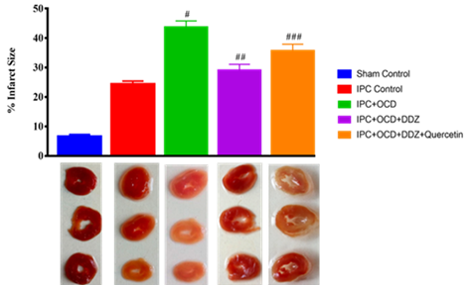Abstract
Diminished testosterone levels conjoined to cardiovascular risk factor mainly myocardial infarction which broadens the risk of cardiovascular mortality referring to age. Ischemic preconditioning (IPC) is one of the interventions to shield such injury. The present study implicated the possible involvement of caveolin and heat shock protein 72 (HSP-72) during stress in orchidectomy (OCD) challenged rats. OCD was performed in male rats and kept for 6 weeks to observe the reduction in the level of testosterone. Isolated perfused heart of normal and OCD group was subjected to ischemic insult as per IPC cycle. Myocardial infarct size, haemodynamic, enzymatic and oxidative stress parameter were assessed for each heart. Diadzein (DDZ) a caveolin inhibitor was administered before the isolation of heart and it significantly decreases myocardial infarct size, release of lactate dehydrogenase, creatinine kinase and oxidative stress marker. DDZ also potentiated the effect IPC-mediated increase in the heart rate and coronary flow. The effect of caveolin inhibitor was remarkably reduced by quercetin administered before 1 h. of the administration DDZ. The findings of this study revealed that protection of myocardium induced by caveolin inhibitor pretreatment has not been lost in OCD rat heart.
Full text article
References
Abete, P., et al. 1996. Preconditioning does not prevent postischemic dysfunction in aging heart. Journal of the American College of Cardiology, 27(7):1777–1786.
Ajmani, P., et al. 2011. Possible involvement of caveolin in attenuation of cardioprotective effect of ischemic preconditioning in diabetic rat heart. BMC Cardiovascular Disorders, 11(1):43.
Asea, A. 2005. Stress proteins and initiation of immune response: chaperokine activity of hsp72. Exercise immunology review, 11:34–45.
Calabrese, V., et al. 2012. Cellular stress responses, hormetic phytochemicals and vitagenes in aging and longevity. Biochimica et Biophysica Acta (BBA) Molecular Basis of Disease, 1822(5):753–783.
Charan, K., et al. 2016. Role of atrial natriuretic peptide in ischemic preconditioning–induced cardio protection in the diabetic rat heart. Journal of Surgical Research, 201(2):272–278.
Chow, A. M., et al. 2009. Hsp72 chaperone function is dispensable for protection against stress-induced apoptosis. Cell Stress and Chaperones, 14(3):253– 263.
Chrisostome, B. J. 2012. Protection of the Ischemic Myocardium during the Reperfusion: Between Hope and Reality. Journal of Developing Drugs, 01(04):1–8.
Ellman, G. L. 1959. Tissue sulfhydryl groups. Archives of Biochemistry and Biophysics, 82(1):70– 77.
Ferdinandy, P., et al. 1998. Adaptation to myocardial stress in disease states: is preconditioning a healthy heart phenomenon? Trends in Pharmacological Sciences, 19(6):223–229.
Ferdinandy, P., et al. 2007. Interaction of Cardiovascular Risk Factors with Myocardial Ischemia/Reperfusion Injury, Preconditioning, and Postconditioning. Pharmacological Reviews, 59(4):418–458.
Fryer, R. 2002. Therapeutic receptor targets of ischemic preconditioning. Cardiovascular Research, 55(3):520–525.
Goyal, A., et al. 2016. Abrogated cardioprotective effect of ischemic preconditioning in ovariectomized rat heart. Human & Experimental Toxicology, 35(6):644–653.
Guisasola, M. C., et al. 2006. Heat shock proteins, end effectors of myocardium ischemic preconditioning? Cell Stress & Chaperones, 11(3):250–258.
Horikawa, Y., et al. 2014. Signaling Epicenters: The Role of Caveolae and Caveolins in Volatile Anesthetic Induced Cardiac Protection. Current Pharmaceutical Design, 20(36):5681–5689.
Hosseini, L., et al. 2020. Melatonin and Nicotinamide Mononucleotide Attenuate Myocardial Ischemia/Reperfusion Injury via Modulation of Mitochondrial Function and Hemodynamic Parameters in Aged Rats. Journal of Cardiovascular Pharmacology and Therapeutics, 25(3):240–250.
Marklund, S., Marklund, G. 1974. Involvement of the Superoxide Anion Radical in the Autoxidation of Pyrogallol and a Convenient Assay for Superoxide Dismutase. European Journal of Biochemistry, 47(3):469–474.
Muller, A. L., Dhalla, N. S. 2010. Mechanisms of the Beneficial Actions of Ischemic Preconditioning on Subcellular Remodeling in Ischemic-Reperfused Heart. Current Cardiology Reviews, 6(4):255–264.
Murray, C. J., Lopez, A. D. 1997. Alternative projections of mortality and disability by cause 1990– 2020: Global Burden of Disease Study. The Lancet, 349(9064):1498–1504.
Oh, Y. S., et al. 2011. Modulation of Insulin Sensitivity and Caveolin-1 Expression by Orchidectomy in a Nonobese Type 2 Diabetes Animal Model. Molecular Medicine, 17(1-2):4–11.
Pachauri, P., et al. 2017. Angiotensin (1–7) facilitates cardioprotection of ischemic preconditioning on ischemia–reperfusion-challenged rat heart. Molecular and Cellular Biochemistry, 430(1-2):99– 113.
Sadri, M., Ahmadi, R. 2013. The Effects of Orchidectomy on Serum Cortisol Level in Male Rats. International Conference on Medical Sciences and Chemical Engineering, pages 27–28.
Schilling, J. M., et al. 2018. Caveolins as Regulators of Stress Adaptation. Molecular Pharmacology, 93(4):277–285.
Sharma, P. L., et al. 2010. Mechanism of cardioprotective effect of erythropoietin-induced preconditioning in rat heart. Indian Journal of Pharmacology, 42(4):219–223.
Sharma, S., et al. 2012. Ameliorative effect of daidzein: a caveolin-1 inhibitor in vascular endothelium dysfunction induced by ovariectomy. India Journal of Experimental Biology, 50(1):28– 34.
Snoeckx, L. H. E. H., et al. 1986. Myocardial function in normal and spontaneously hypertensive rats during reperfusion after a period of global ischaemia. Cardiovascular Research, 20(1):67–75.
Snoeckx, L. H. E. H., et al. 1993. Differences in ischaemia tolerance between hypertrophied hearts of adult and aged spontaneously hypertensive rats. Cardiovascular Research, 27(5):874–881.
Sobey, C. G., et al. 2004. Effect of Short-Term Phytoestrogen Treatment in Male Rats on Nitric Oxide-Mediated Responses of Carotid and Cerebral Arteries: Comparison with 17β-Estradiol. Journal of Pharmacology and Experimental Therapeutics, 310(1):135–140.
Varshney, V., et al. 2017. Role of erythropoietin in ischemic postconditioning induced cardioprotection in hyperlipidemic rat heart. Journal of Indian College of Cardiology, 7(2):72–77.
Yadav, H. N. 2010. Modulation of the cardioprotective effect of ischemic preconditioning in hyperlipidaemic rat heart. European Journal of Pharmacology, 643(1):78–83.
Yadav, H. N., et al. 2010. Involvement of GSK- 3β in attenuation of the cardioprotective effect of ischemic preconditioning in diabetic rat heart. Molecular and Cellular Biochemistry, 343(1-2):75– 81.
Authors

This work is licensed under a Creative Commons Attribution-NonCommercial-NoDerivatives 4.0 International License.

